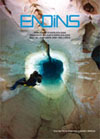| Registro completo | |
|---|---|

Accedir a l'exemplar |
|
| Títol: |
 Proposta d'una nova classificació morfogenètica de les cavitats càrstiques de l'illa de Mallorca
Proposta d'una nova classificació morfogenètica de les cavitats càrstiques de l'illa de Mallorca |
| Autor/es | Ginés, Joaquín ; Ginés, Ángel |
| Matèries en català: | Espeleologia. |
| Matèries en anglès: | Speleology. |
| Resum-Abstract: | [spa] Las importantes exploraciones y descubrimientos, especialmente los realizados durante los últimos quince años en el subsuelo de Mallorca, ponen de manifiesto una complejidad creciente en lo que respecta a los mecanismos genéticos responsables de la formación de las cavidades kársticas de la isla. Estos hechos hacen necesaria la reelaboración de una clasificación morfogenética que actualice los conocimientos que eran válidos hace algunas décadas –concretamente la sistematización propuesta por GINÉS (1995)– y que sea capaz de dar cuenta de la gran variedad de ambientes representados en el mundo subterráneo mallorquín. La clasificación que aquí se propone mantiene, en líneas generales, las cuatro grandes categorías establecidas con anterioridad, las cuales resultan enunciadas de la siguiente manera: 1) simas de la zona vadosa, 2) cuevas de la zona vadosa, 3) cuevas freáticas no litorales, y 4) cuevas de la franja litoral. Dentro de estas categorías se distinguen hasta catorce modalidades genéticas diferenciadas, aportando en cada caso ejemplos significativos que las ilustren convenientemente. Las principales novedades de esta clasificación consisten, por una parte, en el reconocimiento del papel de la disolución de yesos subyacentes en la génesis de algunas cuevas de hundimiento de la Serra de Tramuntana; por otra parte, queda en la actualidad suficientemente documentada la existencia de procesos de espeleogénesis hipogénica, de carácter geotermal, que en algunos casos han actuado conjuntamente con los mecanismos de disolución ligados a la zona de mezcla litoral. [eng] During the last fifteen years, the important explorations and discoveries performed in Mallorcan caves put forward an increasing complexity regarding the mechanisms involved in the genesis of the endokarst phenomena in the island. Those recent contributions strongly claimed for the re-elaboration of a morphogenetic classification of caves in our geographical area, which updates the former existing knowledge –particularly, the systematization proposed by GINÉS (1995)– being able as well to give account for the great diversity of underground environments represented in Mallorca. The classification proposed in this paper distinguishes, in general terms, the four wide hydrogeological categories previously established: 1) vertical shafts of the vadose zone, 2) caves of the vadose zone, 3) inland phreatic caves, and 4) caves of the littoral fringe. Within these categories, up to fourteen genetic typologies are differentiated, supplying at the same time significant examples that conveniently illustrate each case. The most important novelties of the present classification are, on one hand, the recognition about the role of subjacent gypsum dissolution in the genesis of some breakdown caves in Serra de Tramuntana region. On the other hand, nowadays it appears today sufficiently documented the existence of hypogene speleogenesis phenomena, of a geothermal character, that in some cases have acted together with the solutional mechanisms linked to the coastal mixing zone. |
| Font: | Endins 2009, Vol. 33, pp. 005-018 |
| Identificador: | e-ISSN: 2386-7299 |
| Tipus de document: | info:eu-repo/semantics/article ; info:eu-repo/semantics/publishedVersion |
| Avís legal: | all rights reserved ; info:eu-repo/semantics/openAccess |